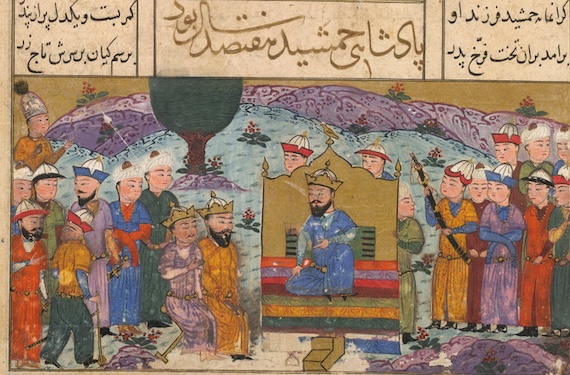I continue with my proposed project of writing a commentary on the first edition of Edward FitzGerald’s translation of the Rubáiyát of Omar Khayyám. FitzGerald was more faithful to the unconventional poetry attributed to Omar Khayyam than is generally thought, but there were moments in his first edition where he drew on images from other Persian poets, especially the Sufi mystic `Abd al-Rahman Jami (d. 1492) of Herat in what is now western Afghanistan. Britannica notes, “His most famous collection of poetry is a seven-part compendium entitled Haft Awrang (“The Seven Thrones,” or “Ursa Major”), which includes Salmān o-Absāl and Yūsof o-Zalīkhā.”
FitzGerald studied Jami with his friend (and likely man-crush) Edward Byles Cowell and produced a loose translation of the romance “Salman and Absal” (he spelled it Salaman). Some of Quatrain 5 is drawn from the latter, as the great scholar A. J. Arberry pointed out (The Romance of the Rubáiyát, 195-196).
V.
Irám indeed is gone with all its Rose,
And Jamshýd’s Sev’n-ring’d Cup where no one knows;
But still the Vine her ancient Ruby yields,
And still a Garden by the Water blows.
The point of this verse is that wine and gardens — symbols of well-being and fulfillment — are eternal, whereas the glories of ancient kingdoms and kings are fleeting.
Arberry points out that there is a reference to Iram in Jami’s Seven Thrones and FitzGerald translated the lines as “Here Iram Garden seem’d in Secresy/ Blowing the Rosebud of its Revelation.”
In Chapter 89 of the Qur’an, 6-8, the question is asked, “Have you not seen how your Lord dealt with `Ad, Iram of the pillars, the like of which was never created in the land?”
This is a reference to Wadi Rum in what is now southern Jordan. Old Arabic inscriptions survive in Wadi Rum referring to it as Iram. The great epigraphist and archeologist Ahmad Al-Jallad at the Ohio University has discovered an Old Arabic inscription from 2,000 years ago mentioning the tribe of `Ad, which lived in Jordan. So the Qur’an was accurately reporting antiquities of a previous time. Trans-Jordan and the northern Hejaz had been ruled by the Arabic-speaking pagan Nabataean kingdom from circa 300 BCE until it was conquered by Rome in 106 CE. By the time of the Qur’an in the early 600s of the Christian era (CE), several old Nabataean cities, such as Hegra or Hijr and the settlements of Wadi Rum had declined and were no longer inhabited. The Qur’an blames this decline on Nabataean polytheism, since in its view only monotheism was a guarantee of a flourishing civilization.
But in the medieval period when the Khayyami poetry and then that of Jami was produced, Iram had become legendary, just a fabled ancient kingdom associated with the vanished `Ad people. FitzGerald thus used the image correctly to refer to a place that was once glorious but now fallen into ruins.
As for the Cup of Jamshid, it features in Zoroastrian mythology, which speaks of a line of ancient kings that included Jamshid. The “j” was pronounced “y” in ancient Persian, which was close to Sanskrit. So this figure was Yima, who also exists in Hindu mythology, as Yama, the god of death and the underworld. Indeed, he is described in the Vedas as the first man who died, and as a judge (dharmaraja), dressed in red finery.
Many figures in Hinduism also exist in Old Persian, but they often take on a different persona. In the ancient Iranian Book of Kings (Shahnameh), Yima or Jamshid is not a god but one of the first kings, whose kingdom at first flourishes epically but then goes into a tailspin. He had a magical chalice (jam) in which he could gaze and which would show him scenes from throughout the world.

Detail. “Jamshid enthroned.” A miniature painting from a fifteenth century manuscript of the epic poem of Shahnama. Image taken from Shahnama. Originally produced in Iran, 1446. British Library.
References to the cup of Jamshid are everywhere in Persian poetry, so FitzGerald wouldn’t have had to read much of it to encounter them. They are certainly in Jami, whose Seven Thrones he studied with Cowell. Scholars have seen a resemblance of the cup of Jamshid to the Holy Grail of medieval European legend; my guess is that they both go back to a common Indo-European myth.
The final two lines may be drawn from the Bodleian manuscript of the Rubáiyát of Omar Khayyám.
In my translation, no. 38 [39 of the Bodleian] has the line “Wine is molten rubies and the bottle is a deep, deep mine,” which bears a resemblance to “But still the Vine her ancient Ruby yields.”
The original is:
می لعل مذاب است و صراحی کان است
mai la`l-e mozab ast o surahi kan ast.
—-
Order Juan Cole’s contemporary poetic translation of the Rubáiyát from
or Barnes and Noble.
or for $16 at Amazon Kindle
——-
The last line, as Arberry says, could reflect Bodleian 147 (my 146):
“and walk with me among the flowers of the river bank”, which could be echoed by “And still a Garden by the Water blows.” “Flowers” in the original is bagh or garden.
بردار پیاله و سبو ای دلجو
برگَرْد به گِردِ باغ و لبِ جو؛
کاین چرخ بسی قَدِّ بُتانِ مَهْرو،
صد بار پیاله کرد و صد بار سبو
In this series:
FitzGerald’s Rubáiyát of Omar Khayyám 1:1
“Awake my little ones and fill the Cup!” FitzGerald’s Rubáiyát of Omar Khayyám 1:2
“Those who Stood before the Tavern” – FitzGerald’s Rubáiyát of Omar Khayyám 1:3
Now the New Year is Reviving old Desires: FitzGerald’s Rubáiyát of Omar Khayyám 1:4
“But still the Vine her ancient Ruby Yields:” Fitzgerald’s Rubáiyát of Omar Khayyám 1:5
“Red Wine!” – the Nightingale cries to the Rose: FitzGerald’s Rubáiyát of Omar Khayyám 1:6
“The Bird is on the Wing”: FitzGerald’s Rubáiyát of Omar Khayyám 1:7.


 © 2025 All Rights Reserved
© 2025 All Rights Reserved